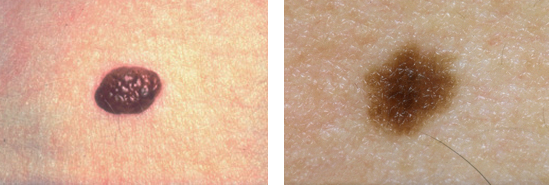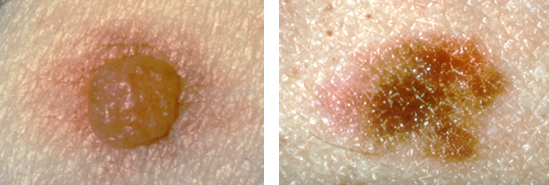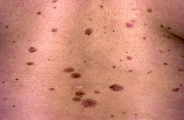March 30, 2017 | Stephen Fine, Founder and President
Normal Moles vs. Atypical Moles
When a person begins educating him or herself about melanoma, some of the first relevant information they’ll come across will be on moles. They’re very important, as 90% of all melanomas begin on the skin and pretty much everyone has them.
Although you’ve surely seen them countless times, you may not be aware that there are two types: normal moles, and atypical moles. (Officially, dysplastic nevi).
Atypical moles have a much greater chance to develop into melanoma than do normal moles. The odds are about 1 in 100 with the former; yet fewer than 1 in 3,000 with the latter. Those who have an atypical mole(s) carry a stronger risk of melanoma. Incidentally, the appearance of hair on any mole is medically irrelevant. It carries no weight with regard to an increased risk of skin cancer.
No one should ever try to tell the two apart without a biopsy; as even a dermatologist cannot be certain without one. However, they do have some distinguishing characteristics that (in general) helps to tell them apart.
For instance, normal moles maintain the same color (most often brown), are round, oval, and sometimes domed in shape. They have well-defined borders and are less than a quarter-inch wide.
These are two examples of normal moles, both raised and flat:

Atypical moles are wider than a quarter-inch and may be multi-colored (brown or pink). They have uneven borders and an irregular shape. Raised dysplastic nevi display a “fried egg” look.
These are two examples of atypical moles, both raised and flat:

Familial Atypical Mole Syndrome
One thing they both do have in common is that their surface areas are usually smooth or cauliflower in texture.
Familial Atypical Mole Syndrome is a disorder that is passed along through our genes. If any close relatives (immediate family but also including grandparents, uncles and aunts) have or have had melanoma and if a large number of atypical moles are present, there’s a high risk of developing the disease.
While monthly self-examination is important for every person of either gender, all races and skin tones, it’s even more vital to those with Familial Atypical Mole Syndrome.
Below is an example of Familial Atypical Mole Syndrome:

*Additional source articles: Cancer.gov, Emedicine.medscape.com
